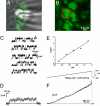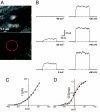Localization-dependent activity of the Kv2.1 delayed-rectifier K+ channel
- PMID: 20566856
- PMCID: PMC2901471
- DOI: 10.1073/pnas.1003028107
Localization-dependent activity of the Kv2.1 delayed-rectifier K+ channel
Abstract
The Kv2.1 K(+) channel is highly expressed throughout the brain, where it regulates excitability during periods of high-frequency stimulation. Kv2.1 is unique among Kv channels in that it targets to large surface clusters on the neuronal soma and proximal dendrites. These clusters also form in transfected HEK cells. Following excessive excitatory stimulation, Kv2.1 declusters with an accompanying 20- to 30-mV hyperpolarizing shift in the activation threshold. Although most Kv2.1 channels are clustered, there is a pool of Kv2.1 resident outside of these domains. Using the cell-attached patch clamp technique, we investigated the hypothesis that Kv2.1 activity varies as a function of cell surface location. We found that clustered Kv2.1 channels do not efficiently conduct K(+), whereas the nonclustered channels are responsible for the high threshold delayed rectifier K(+) current typical of Kv2.1. Comparison of gating and ionic currents indicates only 2% of the surface channels conduct, suggesting that the clustered channels still respond to membrane potential changes. Declustering induced via either actin depolymerization or alkaline phosphatase treatment did not increase whole-cell currents. Dephosphorylation resulted in a 25-mV hyperpolarizing shift, whereas actin depolymerization did not alter the activation midpoint. Taken together, these data demonstrate that clusters do not contain high threshold Kv2.1 channels whose voltage sensitivity shifts upon declustering; nor are they a reservoir of nonconducting channels that are activated upon release. On the basis of these findings, we propose unique roles for the clustered Kv2.1 that are independent of K(+) conductance.
Conflict of interest statement
The authors declare no conflict of interest.
Figures




Similar articles
-
Kv2 channels create endoplasmic reticulum / plasma membrane junctions: a brief history of Kv2 channel subcellular localization.Channels (Austin). 2019 Dec;13(1):88-101. doi: 10.1080/19336950.2019.1568824. Channels (Austin). 2019. PMID: 30712450 Free PMC article. Review.
-
The Kv2.1 C terminus can autonomously transfer Kv2.1-like phosphorylation-dependent localization, voltage-dependent gating, and muscarinic modulation to diverse Kv channels.J Neurosci. 2006 Jan 11;26(2):685-95. doi: 10.1523/JNEUROSCI.4620-05.2006. J Neurosci. 2006. PMID: 16407566 Free PMC article.
-
Comparison of the endogenous IK currents in rat hippocampal neurons and cloned Kv2.1 channels in CHO cells.Cell Biol Int. 2008 Dec;32(12):1514-20. doi: 10.1016/j.cellbi.2008.08.019. Epub 2008 Aug 30. Cell Biol Int. 2008. PMID: 18801450
-
Regulation of intrinsic excitability in hippocampal neurons by activity-dependent modulation of the KV2.1 potassium channel.Channels (Austin). 2009 Jan-Feb;3(1):46-56. doi: 10.4161/chan.3.1.7655. Channels (Austin). 2009. PMID: 19276663 Free PMC article.
-
Dynamic regulation of the voltage-gated Kv2.1 potassium channel by multisite phosphorylation.Biochem Soc Trans. 2007 Nov;35(Pt 5):1064-8. doi: 10.1042/BST0351064. Biochem Soc Trans. 2007. PMID: 17956280 Review.
Cited by
-
K+ channel alterations in the progression of experimental autoimmune encephalomyelitis.Neurobiol Dis. 2012 Aug;47(2):280-93. doi: 10.1016/j.nbd.2012.04.012. Epub 2012 Apr 24. Neurobiol Dis. 2012. PMID: 22560931 Free PMC article.
-
High spatial density is associated with non-conducting Kv channels from two families.Biophys J. 2022 Mar 1;121(5):755-768. doi: 10.1016/j.bpj.2022.01.021. Epub 2022 Jan 31. Biophys J. 2022. PMID: 35101417 Free PMC article.
-
Mechanism of use-dependent Kv2 channel inhibition by RY785.J Gen Physiol. 2022 Jun 6;154(6):e202112981. doi: 10.1085/jgp.202112981. Epub 2022 Apr 18. J Gen Physiol. 2022. PMID: 35435946 Free PMC article.
-
Kv2 channels create endoplasmic reticulum / plasma membrane junctions: a brief history of Kv2 channel subcellular localization.Channels (Austin). 2019 Dec;13(1):88-101. doi: 10.1080/19336950.2019.1568824. Channels (Austin). 2019. PMID: 30712450 Free PMC article. Review.
-
Heteromeric KV2/KV8.2 Channels Mediate Delayed Rectifier Potassium Currents in Primate Photoreceptors.J Neurosci. 2018 Apr 4;38(14):3414-3427. doi: 10.1523/JNEUROSCI.2440-17.2018. Epub 2018 Feb 26. J Neurosci. 2018. PMID: 29483285 Free PMC article.
References
-
- Misonou H, Trimmer JS. Determinants of voltage-gated potassium channel surface expression and localization in mammalian neurons. Crit Rev Biochem Mol Biol. 2004;39:125–145. - PubMed
-
- Tamarina NA, Kuznetsov A, Fridlyand LE, Philipson LH. Delayed-rectifier (KV2.1) regulation of pancreatic beta-cell calcium responses to glucose: Inhibitor specificity and modeling. Am J Physiol Endocrinol Metab. 2005;289:E578–E585. - PubMed
Publication types
MeSH terms
Substances
Grants and funding
LinkOut - more resources
Full Text Sources
Medical
Miscellaneous

